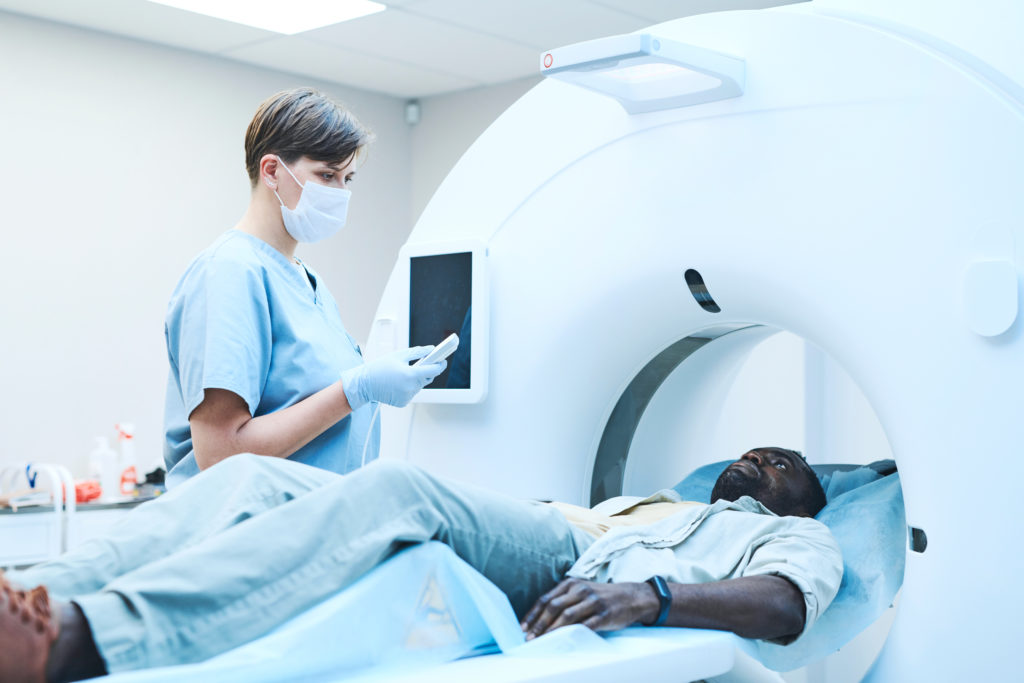Ann S. glances at the clock beside her bed and realizes she still has three more hours before her alarm goes off. She struggles with sleep, knowing her MRI is at 7 a.m. She has been counting down the days for the past week, her anxiety growing as the date inches closer. Ann undergoes an MRI every two months to look for any regrowth following her glioblastoma diagnosis in July 2021.
“I get anxious about my scanning, but I had never heard of the word scanxiety until today,” Ann shared. “I think it’s very high anxiety-producing because it basically decides whether the last two months of chemotherapy have been working. It’s going to decide whether I’m going to stay alive.”
What is Scanxiety?
For individuals like Ann living with a brain tumor, imaging tests, such as MRIs, CT scans, and PET scans, are an integral part of the treatment plan. While these scans are often part of routine care, they can be one of the most stressful and sensitive parts of a patient’s experience.
The term scanxiety describes the stress, anxiety, worry, and fear leading up to, during, and after any medical imaging. It’s a common and normal response for many people living with a brain tumor.
“I have been honored to serve and interact with many individuals living with a brain tumor,” Alexa Greenstein, MSN, RN, FNP-C, a neuro-oncology nurse practitioner at Kaiser Permanente, said. “Scanxiety comes up repeatedly in our conversations, whether in a clinic room or a support group. It’s completely normal to feel stressed and anxious before, during, or after a scan, whether it’s the first or the 50th.”
National and international institutions such as MD Anderson and Dana-Farber, organizations like the American Society of Clinical Oncology (ASCO), and neuro-oncology providers have recognized scanxiety as a part of the cancer experience.
“Scanxiety is not a term found in any dictionary, but it’s certainly a term found in many support groups, radiology departments, and neuro-oncology clinics because it’s just that common,” Victoria Best, PharmD, BCGP, RPh, said.
Signs and Symptoms of Scanxiety
Anytime an individual feels anxious, worried, or stressed, a chemical and hormonal reaction occurs in the body, known as the fight or flight response. This reaction can cause physical, emotional, and cognitive changes.
Scanxiety can cause a range of physical symptoms such as increased heart rate, rapid breathing, muscle tension, nausea, digestive and appetite changes, dizziness, sweating, fatigue, and headaches.
“These symptoms can and may be related or caused by other medical and psychological conditions,” Alexa said. “If someone is experiencing symptoms before, during, or after a scan, even if minor, it’s important to let the health care team know because they will want to help assess and manage these symptoms and concerns.”
Sometimes scanxiety can have other symptoms or manifestations that aren’t physical. For example, scanxiety can affect mood, relationships, the ability to sleep, and even how they function in daily life. Some people may experience mood swings or become irritable, easily angry or agitated, withdrawn, detached, or isolated from family and friends. Other individuals may be more preoccupied, having difficulties concentrating and staying motivated.
These symptoms can range from mild to intense and can be disruptive, impacting one’s quality of life. While it’s normal to have scanxiety, patients should speak with their health care team if scanxiety is interfering with their daily life.
Timing of Scanxiety
Each person’s experience is unique, so scanxiety can present in many distinctive ways, involving different emotions and feelings at various points throughout the scan process.
Before the Scan
Individuals may find themselves feeling worried and anxious about the scan and the test results in the lead-up to the scan. Sometimes they may find it nearly impossible to think about much else, imagining and playing out all the worst-case scenarios.
Scans can prompt a range of emotions, thoughts, memories, and reactions. Because there is a lot at stake with each scan, it can be a time of heightened uncertainty, perhaps bringing back memories and trauma of when they were diagnosed with brain cancer.
“The anxiety before a scan is the reminder that I have a brain tumor and that more than likely the brain tumor will be what ends my life,” Brett J., who was diagnosed with oligodendroglioma approximately 10 years ago, said. “These scans are to find out if the tumor is active or not. As I get closer — usually a few weeks — I face the reality that this brain tumor could kill me, and this scan is a marker. That’s what scans do. They remind you that everything could change on a dime today.”
Individuals may experience the apprehension of what the scan may or may not reveal: new findings, disease progression, disease recurrence, treatment failure, or mortality. All of this can amplify feelings of insecurity, anxiety, and helplessness.
“A scan is a determination of what’s happened and what I have to do next,” Ann explained. “The scan is highly decisive about my quality of life.”
During the Scan
Some people experience unpleasant feelings during the scan itself. The scan can be upsetting and challenging for individuals because of:
- Being confined within the tight space of the imaging machine
- Needing to stay still for long periods of time
- Hearing loud noises
- Having needles placed for IV access
- Drinking contrast liquids
“The MRI of my brain is the only time in a 2-month period I have to think about my brain tumor without any options for changing the topic, talking with someone, or changing my activity,” Ann explained.
After the Scan
For many, the most challenging part and when they experience the greatest scanxiety is after the scan. Waiting for results can be very scary and nerve-wracking. What did the scan find or not find?
Depending on the health care system, test results may go straight to a patient portal before the patient can discuss the results with their medical team to gain a clear understanding of what the scan found. For many, receiving results this way can cause heightened anxiety and worry.
Impact on Loved Ones
Scanxiety is prevalent not only in the patients undergoing medical imaging, but it can also present in their family and friends at varying points in the scan process.
“Family members, loved ones, and friends can also have their own worries and fears and experience increased levels of anxiety around scans,” Alexa said.
Ask for Help
Once someone understands what scanxiety is, the individual can look for potential signs of scanxiety in their own life. If the patient finds that they are experiencing a form of scanxiety before, during, or after a scan, they should discuss their concerns with their health care team and look for ways to reduce their scanxiety symptoms, including managing scanxiety through self-care.





